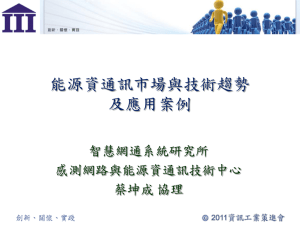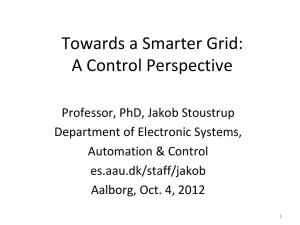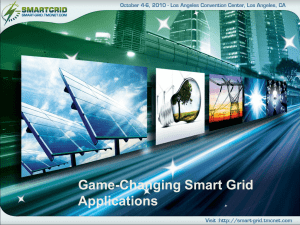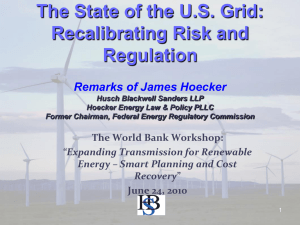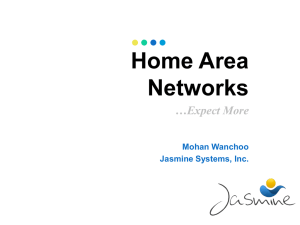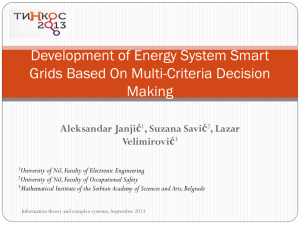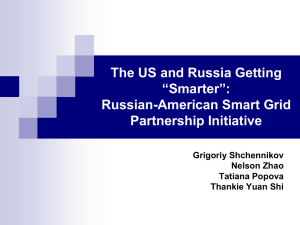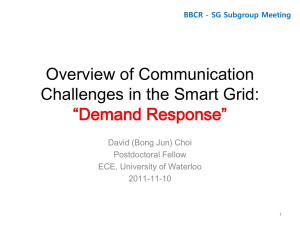Architecture and Infrastructure Issues in Automatic Meter Reading
advertisement
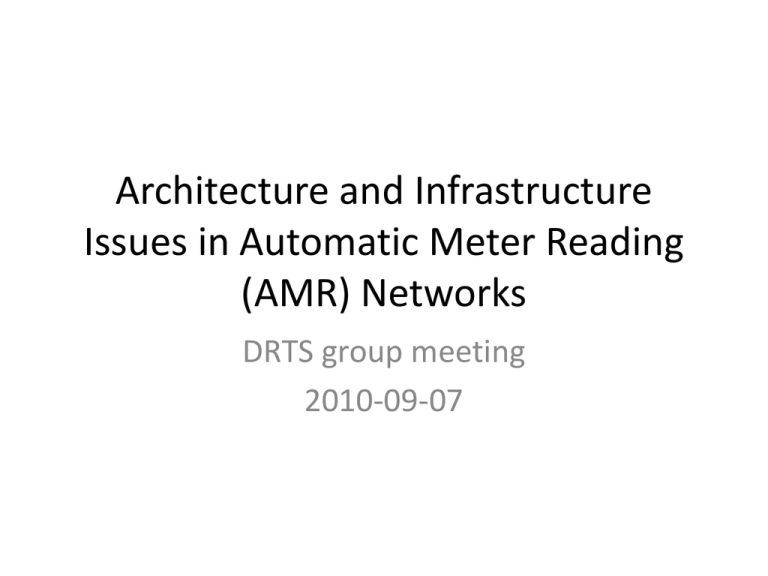
Architecture and Infrastructure Issues in Automatic Meter Reading (AMR) Networks DRTS group meeting 2010-09-07 What is AMR? • Automatic Meter Reading – Correct invoice every month – New infrastructure for a single application – Expensive (14 BSEK, Sweden) – Little value • Raise energy customer awareness – ”New” requirement on the AMR infrastructure – Other applications to come? Technologies • PLC – Cheap, slow, old – The principle used for many years • Hybrids – Actual use is a cost-balance choise • GPRS/GSM/cell data – Most useful and expensive, good coverage Cost-effective and scalable • Tidaholm Energi – Advanced meters, homogenous (Aidon meter) – 8-10 parameters, all collected batch-wise (1h) – 7000 subscribers • Vattenfall – Need inexpensive AMI, heterogenous – Filtering out 1 parameter / month (1m) – 1 100 000 subscribers (Sweden), 7.8 M overall Challenges • Real-time propagation of updates – Propagated as raw, or aggregated – Central and distributed usage of updates – 9 hours delay of 24h readings No RT applications • Is GPRS the solution? – Cost-effective? Cheaper circuits and data plans. – Telecom systems are built to scale. Infrastructure exists. • Is IP the solution? – IP everywhere: ”Internet of things” – IP is scalable. Infrastructure exists. Large foot-print? Envolve project themes Envolve Energy involvement and engagement Enlight Engage AMMend Aware End user awareness of own energy efficiency Involve next generation energy users Awareness of the status of the electricity grid Situation awareness for societal functions Pre-studies • Data modeling (Aug ’10 – Mar ’11) Understand energy consumption patterns – Build user behavioral models from data – Is current data enough to get new knowledge? – Which sources to fuse? • Data collection (Aug ’10 – Mar ’11) Understand architectural needs – Fusion, where and how? – Scalability and hierarchy – Which users of new knowledge? Data collection pre-study • How to – Ensure connectivity – Enable real-time performance – Make use of distributed fusion – Support large-scale, short-interval data collection and processing – Support future communication needs Project proposals Project: Max Peak Shifting • Demand-Response decision support – How far can behavioral adaptation go? – How far can decision support go? • Active controller for peak shifting – Spot price vs. load in home – Appliances and smart plugs – Simple user control for decision support, schedule and policy-based actuation – Prioritized load groups in home • Scale up a demonstration model home – Simulation-based study for large-scale effect www.his.se/infofusion/envolve 10 Project: Trends and Alarms • Use aggregated behavior – Anomalies in time series – For individuals or groups • “Virtual sensors”, “indicators” – Interoperability and architectural needs? – Users of the knowledge? • From sector indicators to overall indicator – Fuse with other data sources: Retail, Telephone, SOS Alarm, SMHI, season, .. www.his.se/infofusion/envolve 11 Project: Measure for applications • Next useful applications (“ next killer apps”) – What is the very best possible? – Applications decide what to measure – Applications drive development by needs • Data is central – Data owner, beneficiary, infrastructure – Derived-knowledge owner – Flexible and open data infrastructure is needed www.his.se/infofusion/envolve Measurements, Raw data Applications 12 Project: Magic Advisor • Capitalize on model of behavioral profiles – Give advise to move between profiles – Compare trends with current profile • Improved model – Fuse with additional data sources – Improved real-time and alarms • Innovative user interface – Leverage the involvement, multi-modal? • Added services – Sub-meter installations for refined profiling – Better CR for Utility companies www.his.se/infofusion/envolve 13 Where is research today? • "Fusion" - A Comparative Study of Data Storage and Processing Architectures for the Smart Grid • Demand and Response - Demand Side Load Management using a Three Step Optimization Methodology - Power Demand Shifting with Smart Consumers - Control Mechanisms for Residential Electricity Demand in SmartGrids - Dynamic Load Modeling of an HVAC Chiller for Demand Response Applications • Architectures - Smart Grid Data Cloud: A Model for Utilizing Cloud Computing in the Smart Grid Domain - Demand Response Architecture- Integration into the Distribution Management System - Incentive Design for Lowest Cost Aggregate Energy Demand Reduction - A Unified Solution for Advanced Metering Infrastructure Integration with a Distribution Management System - Seamless Data Communication and Management over all Levels of the Power System • Communication - High Assurance Smart Grid: Smart Grid Control Systems Communications Architecture - Facilitating a Generic Communication Interface to Distributed Energy Resources Mapping IEC 61850 to RESTful Services - WattDepot: An Open Source Software Ecosystem for Enterprise-scale Energy Data Collection, Storage, Analysis, and Visualization - Scalability of Smart Grid Protocols - Protocols And Their Simulative Evaluation For Massively Distributed DERs - SmartGridLab: A Laboratory-Based Smart Grid Testbed • Privacy - Malicious Data Attacks on Smart Grid State Estimation: Attack Strategies and Countermeasures - Privacy for Smart Meters: Towards Undetectable Appliance Load Signatures - Smart Grid Privacy via Anonymization of Smart Metering Data - Survey of Smart Grid Standardization Studies and Recommendations
